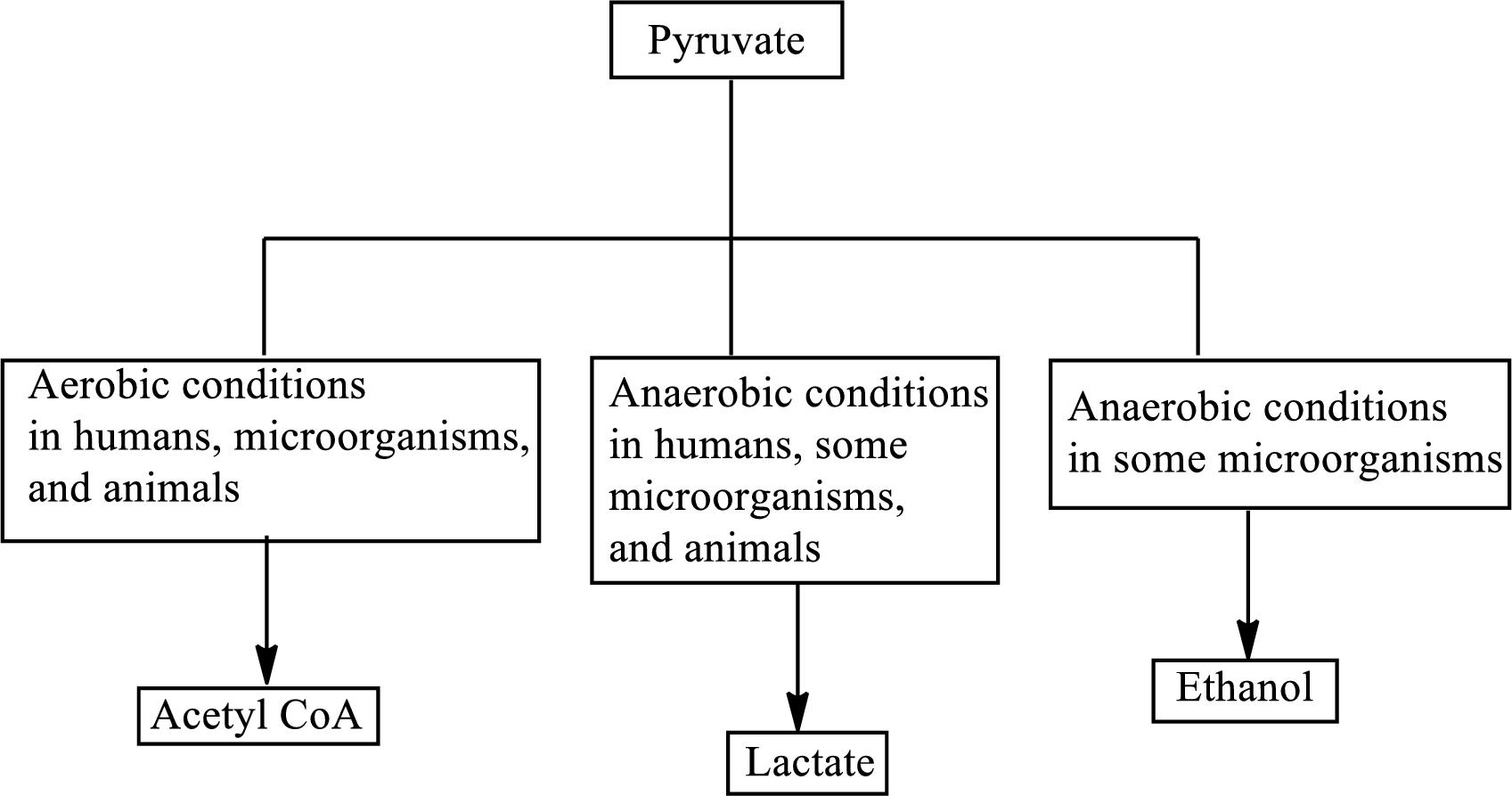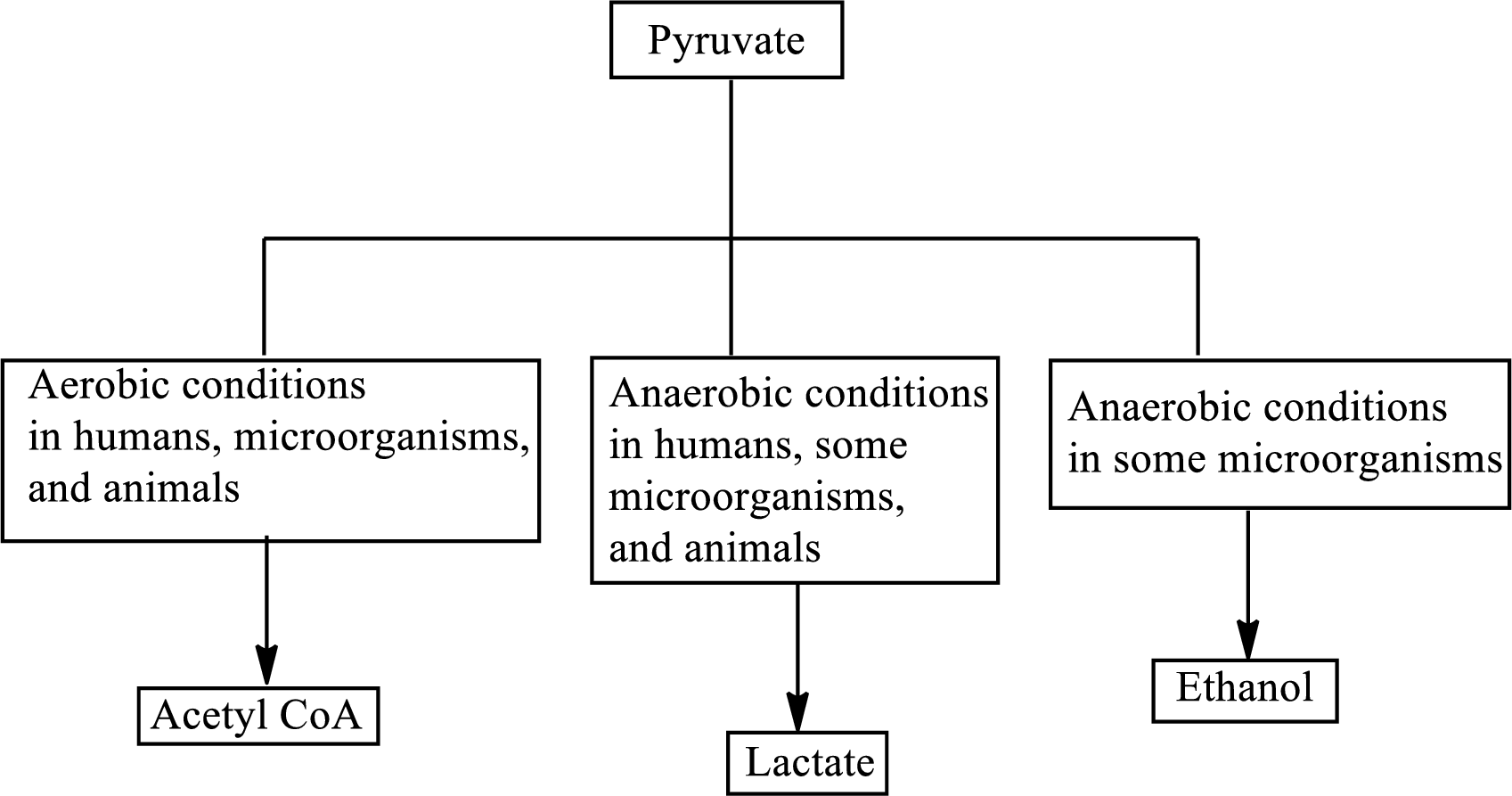
Concept explainers
(a)
Interpretation: To indicate whether pyruvate is associated with (1) glycolysis, (2) pyruvate oxidation, (3) lactate fermentation, or (4) ethanol fermentation.
Concept introduction: Pyruvate
(b)
Interpretation: To indicate whether
Concept introduction: In the glycolysis metabolic pathway, a glucose molecule breaks down into two pyruvate molecules. Two ATP molecules and NADH reduced coenzymes are produced in the glycolysis pathway.
Pyruvate is the end product in the glycolysis. The production of the fate of pyruvate varies with the nature of the organism and the cellular conditions.
Coenzymes are non-protein organic compounds that are used along with the enzymes and help to carry forward the reaction. Coenzymes cannot perform on their own alone.
(c)
Interpretation: To indicate whether ADP is associated with (1) glycolysis, (2) pyruvate oxidation, (3) lactate fermentation, or (4) ethanol fermentation.
Concept introduction: In the glycolysis metabolic pathway, a glucose molecule breaks down into two pyruvate molecules. Two ATP molecules and NADH reduced coenzymes are produced in the glycolysis pathway.
Adenosine diphosphate (ADP) provides energy to carry out the metabolic processes in the living cells.
The production of the fate of pyruvate varies with the nature of the organism and the cellular conditions. The three common fates of pyruvate are as follows:

(d)
Interpretation: To indicate whether
Concept introduction: In the glycolysis metabolic pathway, a glucose molecule breaks down into two pyruvate molecules. Two ATP molecules and NADH reduced coenzymes are produced in the glycolysis pathway. The production of the fate of pyruvate varies with the nature of the organism and the cellular conditions. The three common fates of pyruvate are as follows:

Nicotinamide adenine dinucleotide is associated with the
Trending nowThis is a popular solution!

Chapter 24 Solutions
EBK GENERAL, ORGANIC, AND BIOLOGICAL CH
- Which of the following distinguishes lactate fermentation from alcoholic fermentation? (Only one answer is correct) A. CO2 is not produced during lactate fermentation. B. Pyruvate is an input to regenerate NAD+ during lactate fermentation. C. Two ATP are used to initiate glycolysis during lactate fermentation. D. Four ATP are produced by glycolysis during lactate fermentation.arrow_forwardWhich of the following is NOT a component of the pyruvate dehydrogenase complex? a. dihydrolipoyl dehydrogenase b. dihydrolipoyl transacetylase c. pyruvate dehydrogenase d. dihydrolipoyl catalasearrow_forwardFive coenzymes are required by a-ketoglutarate dehydrogenase, the enzyme in the citric acid cycle that converts a-ketoglutarate to succinyl-CoA.a. Identify the coenzymes.b. Propose a mechanism for the reaction.arrow_forward
- In the reaction catalyzed by malate dehydrogenase, which of the following molecules is classified as the reduced donor? a. Malate b. Oxaloacetate c. Fumerate d. FAD e. FADH2 f. NAD+ g. NADHarrow_forwardWhich of the following enzymes possesses a catalytic mechanism extremely similar to that of the Pyruvate Dehydrogenase Complex? A. the isocitrate dehydrogenase B. the succinate dehydrogenase C. the alpha-ketoglutarate dehydrogenase D. the malate dehydrogenasearrow_forwardCompare lactic acid fermentation and alcohol fermentation as both known as anaerobic respiration. * A. Water is added only with alcohol fermentation. B. Pyruvate is reduced by NADH only in alcohol fermentation. C. Carbon dioxide is released only with lactic acid fermentation D. Lactic acid fermentation ends with a 3 carbon compound while alcohol fermentation ends with a 2-carbon compound.arrow_forward
- Which of the following number of products from the Krebs Cycle is a manifestation of 4 pyruvate molecules generated from glycolysis? A. 2 ATP, 6 NADH, 2 FADH₂ B. 3 ATP, 9 NADH, 3 FADH₂ C. 4 ATP, 4 NADH, 4 FADH₂ D. 4 ATP, 12 NADH, 4 FADH₂arrow_forwardThe glycolysis reaction map indicates that is also a substrate for the pentose phosphate pathway (PPP), while product of the PPP and an intermediate for glycolysis. A. \beta-D-Glucose-6-phosphate; glyceraldehyde-3-phosphate B. \alpha - D- Glucose-6-phosphate; glyceraldehyde-3- phosphate C. \alpha-D-Glucose-6-phosphate; glycerate D. \alpha-D-Glucose-6-phosphate; glycerate-3-phosphate is aarrow_forwardThe coenzymes required for the activity of the pyruvate dehydrogenase complex are a. biotin, thiamine pyrophosphate, CoASH, and lipoic acid b. lipoic acid, NAD+, thiamine pyrophosphate and FAD c. NAD+, lipoic acid, tetrahydrofolate, CoASH d. biotin, tetrahydrofolate, vitamin B6arrow_forward
- Which of the following statements about the TCA cycle is INCORRECT? O a. The TCA cycle can recover much more energy than homolactic fermentation. b. All reactions of the TCA cycle take place in the mitochondria. C. The energy released in the TCA cycle is mainly stored in the reduced electron carriers NADH and FADH₂. O d. Under anaerobic conditions the TCA cycle is used to oxidize pyruvate. Oe. The TCA cycle is also called the citric acid cycle after the product of the first reaction catalyzed by pyruvate dehydrogenase.arrow_forwardThe aspartate–malate shuttle transfers electrons from cytoplasmic NADH to the electron transport system. Which of the following molecules is not directly involved in this pathway? a. malate b. oxaloacetate c. citrate d. α-ketoglutaratearrow_forwardWhich of the following statements concerning alcoholic fermentation is NOT true? a. It occurs under aerobic conditions in yeast. b. It converts pyruvate into ethanol and CO2. c. One molecule of NADH is consumed. d. It generates NAD+ for reuse by glycolysis.arrow_forward
 Human Anatomy & Physiology (11th Edition)BiologyISBN:9780134580999Author:Elaine N. Marieb, Katja N. HoehnPublisher:PEARSON
Human Anatomy & Physiology (11th Edition)BiologyISBN:9780134580999Author:Elaine N. Marieb, Katja N. HoehnPublisher:PEARSON Biology 2eBiologyISBN:9781947172517Author:Matthew Douglas, Jung Choi, Mary Ann ClarkPublisher:OpenStax
Biology 2eBiologyISBN:9781947172517Author:Matthew Douglas, Jung Choi, Mary Ann ClarkPublisher:OpenStax Anatomy & PhysiologyBiologyISBN:9781259398629Author:McKinley, Michael P., O'loughlin, Valerie Dean, Bidle, Theresa StouterPublisher:Mcgraw Hill Education,
Anatomy & PhysiologyBiologyISBN:9781259398629Author:McKinley, Michael P., O'loughlin, Valerie Dean, Bidle, Theresa StouterPublisher:Mcgraw Hill Education, Molecular Biology of the Cell (Sixth Edition)BiologyISBN:9780815344322Author:Bruce Alberts, Alexander D. Johnson, Julian Lewis, David Morgan, Martin Raff, Keith Roberts, Peter WalterPublisher:W. W. Norton & Company
Molecular Biology of the Cell (Sixth Edition)BiologyISBN:9780815344322Author:Bruce Alberts, Alexander D. Johnson, Julian Lewis, David Morgan, Martin Raff, Keith Roberts, Peter WalterPublisher:W. W. Norton & Company Laboratory Manual For Human Anatomy & PhysiologyBiologyISBN:9781260159363Author:Martin, Terry R., Prentice-craver, CynthiaPublisher:McGraw-Hill Publishing Co.
Laboratory Manual For Human Anatomy & PhysiologyBiologyISBN:9781260159363Author:Martin, Terry R., Prentice-craver, CynthiaPublisher:McGraw-Hill Publishing Co. Inquiry Into Life (16th Edition)BiologyISBN:9781260231700Author:Sylvia S. Mader, Michael WindelspechtPublisher:McGraw Hill Education
Inquiry Into Life (16th Edition)BiologyISBN:9781260231700Author:Sylvia S. Mader, Michael WindelspechtPublisher:McGraw Hill Education





